Lettuce is an annual plant categorized as ‘easy to grow.’ However, when your lettuce plants start dying, you can be left scratching your head wondering why. There are several reasons your easy-to-grow lettuce plants are suddenly dying.
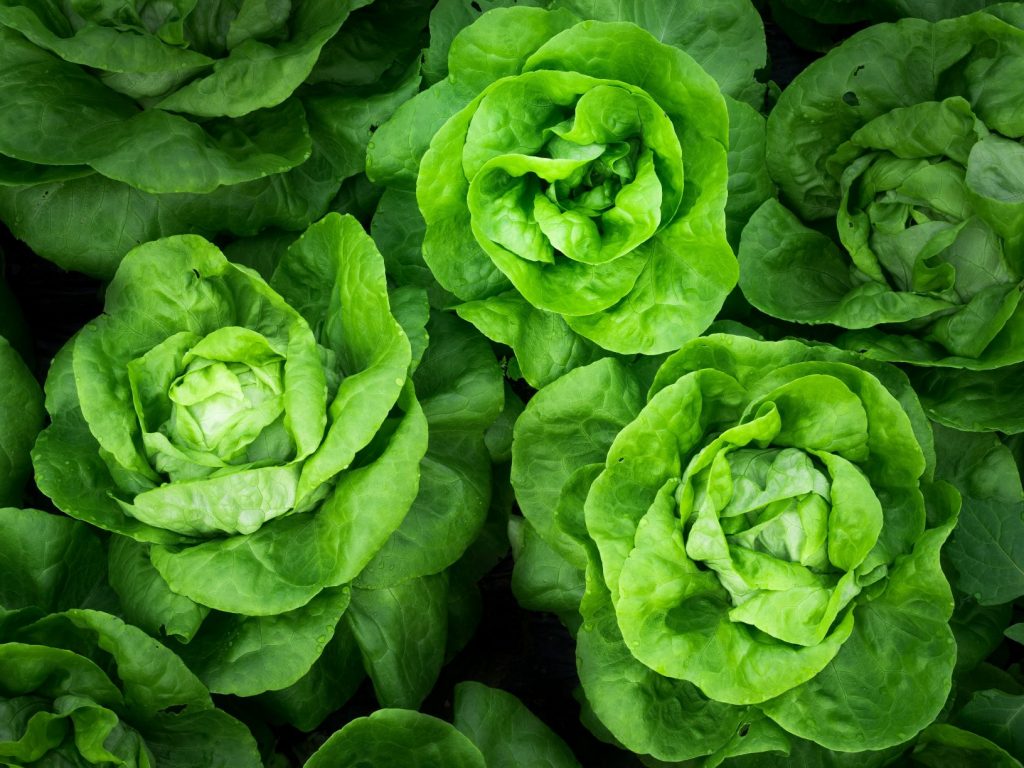
Table of Contents
Why Is My Lettuce Dying?
The most likely reasons your lettuce is dying are watering issues, too much or too little sunlight, a lack of nutrients in the soil, extreme temperatures, crowded growing conditions, certain pests, and diseases.
Read on to find out more about the most likely reasons why your lettuce is dying, and how to fix them!
Related: How To Grow Lettuce | Spots on Arugula? Causes and Solutions
1. Watering Issues
Watering issues are the most common reason behind dying lettuce, as both too much or too little water can cause your lettuce to die. Lettuce plants have a shallow root system, meaning it can be a bit difficult to get the moisture levels right.
Overwatering
Overwatering lettuce is easy to do, as knowing when to water your plants, and how much water to give them can be tricky. Lettuce plants are often described as being thirsty, meaning they need more water than many other vegetables in your garden. Because of this, it is easy to give them a little bit too much.
If your lettuce is beginning to wilt, its leaves are turning yellow and are soft and mushy, overwatering could be the cause. When lettuce is overwatered, the soil becomes waterlogged, drowning the roots of your plant. When this happens, your lettuce plant is at risk of developing a disease called root rot.
Root rot is when a fungus develops on your plant’s roots, turning them into black mush. When this happens, the roots of your lettuce are unable to transport the nutrients and water from the soil that it needs to survive.
How to Fix it: If you believe you have been overwatering your lettuce, you need to check the soil around your plants. If the soil is wet when you place your finger a few inches in, your plants are dying due to overwatering.
The first thing to do is to stop watering your lettuce immediately, as it needs to dry out before you water it again. If your lettuce plant has root rot, however, it is a bit more difficult to fix. Root rot can not be reversed.
When dealing with root rot, you can try to remove the rotted black portions of the roots, and leaves and replant your lettuce.
Figuring out a watering schedule for your lettuce plants can be a bit tricky, as there are a few factors to take into consideration such as your climate, natural rainfall and soil conditions. Lettuce should get 1 inch of water weekly, but if your soil is sandy you will have to water it more frequently.
Underwatering
Underwatering your lettuce plants can cause them to experience water stress, leading to wilting, drooping leaves, and a generally weakened appearance. If your lettuce plants are not getting enough water, the leaves will begin to curl, look dry, and turn brown.
Additionally, if your lettuce does not get enough water, it can bolt. When your lettuce bolts it will grow tall and begin to flower, marking the end of its life cycle.
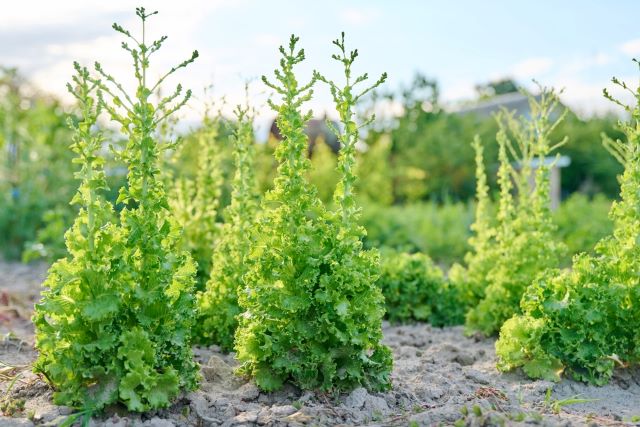
How to Fix it: Just as with overwatering, you will need to adjust your watering schedule if your plants are being underwatered. As a general rule, you should water your lettuce 2-3 times a week. This really is dependent on your climate, how much natural rainfall you receive, and the condition of your soil. So make sure you check the soil throughout the week to see if it is dry. If your soil is dry, you need to water it.
You can also use a soil gauge that monitors the soil moisture for you.
2. Too Much or Too Little Sunlight
Another likely reason your lettuce is dying is due to either too much or too little sunlight as both can stress your lettuce plants.
When your lettuce plants get too much direct or full sunlight in a day, your lettuce can become dehydrated. Too much sun can also lead to sunscald, which is basically sunburn for plants.
If your lettuce plants are getting too little sunlight per day, they won’t be able to photosynthesize. This means your plants won’t be able to get enough energy to grow and will appear pale and yellow.
How to Fix it: Lettuce plants need between 6-8 hours of direct sunlight per day. Any more than this will stress your plant. If your lettuce is receiving more than 8 hours of direct sunlight per day, you can protect it by covering it with shade cloth during the hottest times of the day.
Your lettuce can survive without direct sunlight, and can even continue to grow with just 4 hours of sunlight per day. However, eventually, a lack of sunlight will take its toll on your lettuce plants. The best thing to do if your plants are not getting enough sunlight is to prune back any trees or plants that could limit your lettuce plants’ exposure to the sun, or transplant them to a sunny position in the garden.
3. A Lack of Nutrients in The Soil
Different nutrients play specific roles in supporting various aspects of plant health and function. A lack of nutrients can cause your lettuce to wither and die. If your lettuce plants are dying due to a lack of nutrients in the soil, you will notice yellowing of the leaves, stunted growth, and necrotic spots on the leaves.
The main nutrients that your lettuce plants need to thrive are nitrogen (N), phosphorus (P), and potassium (K).
How to Fix it: The first thing to do if you notice any of the symptoms of nutrient deficiency on your lettuce, is to test the soil. You can check the NPK level in your soil by using a home testing kit.
I like this organic fertilizer to help feed the soil and promote healthy lettuce growth. It is important to remember that too much fertilizer will also kill your lettuce! So only use fertilizer as directed.
Keeping your soil healthy with the addition of compost, aged manure and mulching will help keep lettuce happy and thriving. I like to use compost and manure prior to planting with some top dressing of compost throughout the growing season. This just means spreading handfuls of compost around the plant.
4. Extreme Heat
Extreme heat can have detrimental effects on lettuce plants, leading to their decline and eventual death. Lettuce is considered a cool-season crop and is best suited for moderate temperature ranges. Excessively high temperatures can harm lettuce plants.
Lettuce will thrive in temperatures ranging between 60 to 70 °F (15.5 to 21 °C). Anything above 77 °F (25 °C) will cause your lettuce to experience heat stress. Symptoms of heat stress include wilting, dehydrated leaves, and bolting.
How to Fix it: To protect your lettuce from the hot weather, you can cover it with shade cloth to keep it out of direct sunlight. Additionally, you will need to water your plants more during a heat wave as the soil dries out much quicker.
During a heat wave, I make sure I check my plants every afternoon to see if the soil is dry, if it is, I give them a good soaking.
5. Crowded Growing Conditions
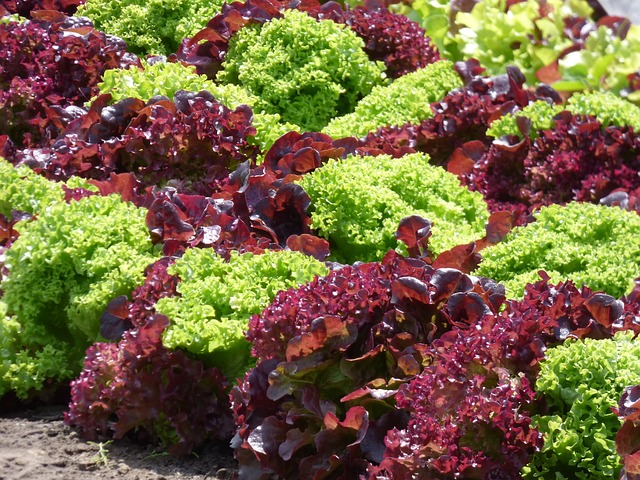
When lettuce is planted too close together it can create several problems, and could be the reason why your lettuce is dying. Overcrowded growing conditions lead to competition for nutrients, as well as reduced light penetration, and poor air circulation in your lettuce patch.
Planting lettuce close together means that each plant is competing for nutrients within the same space, this leads to nutrient depletion in the soil and a nutrient deficiency in your plants.
Similarly, overcrowding restricts sunlight from reaching all parts of the lettuce plants. This leads to uneven growth and reduced photosynthesis. Lettuce plants that are trying to get enough sunlight, grow taller, becoming “leggy,” as they strain for any available sunlight.
When lettuce plants are densely packed, air circulation is hindered, which can lead to higher humidity. This is a problem because it creates the perfect breeding ground for diseases.
How to Fix it: There should be at least 10 inches (25cm) between your leafy varieties of lettuce, while lettuce heads should be planted 12 inches (30cm) apart. If your lettuce is dying due to overcrowding, you will need to thin out your plants.
6. Pests
Lettuce plants are susceptible to various pests that can potentially cause severe damage and, in some cases, even lead to the death of your plant. Here are some common pests that can pose a significant threat to lettuce:
Aphids
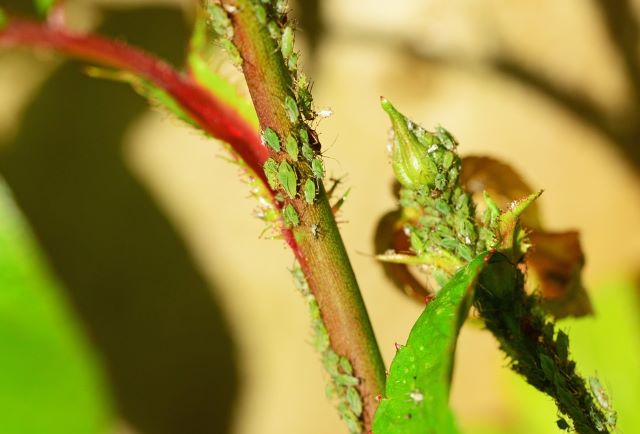
Ah, aphids, these tiny, sap-sucking insects are one of the more irritating common pests encountered by home gardeners. Aphids are soft-bodied, white, green or black, little pests that like to hang out in groups on the stems and undersides of your lettuce leaves.
While the feeding habits of aphid colonies on your plants may not cause damage that initially alarms you, they can be the cause of your dying lettuce. Aphids spread one of the most devastating diseases that can affect your lettuce, the lettuce mosaic virus.
How to Fix it: Unlike the disease they spread, aphids are fairly easy to get rid of, although they are persistent. The first step in fixing your aphid problem is to blast them (gently!) off your lettuce with the garden hose. Next, apply a mixture of 1 tablespoon of dishwashing liquid, mixed with 1 liter of water to your plants. You should do this every 2-3 days for 2 weeks. You can also use insecticidal soap spray.
Root-knot Nematodes
Root-knot nematodes are microscopic parasitic roundworms that can infest the soil and attack the roots of lettuce plants. They cause root galling, stunted growth, wilting, and discoloration of the leaves which will eventually lead to death.
How to Fix it: Sadly, there is no way to fix a lettuce plant that has been attacked by root-knot nematodes.
To remove the root-knot nematodes from your soil one method is to solarize it, which is when you harness the power of the sun to kill the parasites.
To solarize your soil you will need to thoroughly wet it, till it, and cover it with a tarp that is weighted down on the edges. The tarp should be left to bake in the sun for two months during summer.
Another method, which is my preferred method, is to introduce beneficial nematodes which are safe to use in organic gardening and will take care of the bad nematodes for you! Planting marigolds is also helpful to control pest nematodes.
Cutworms
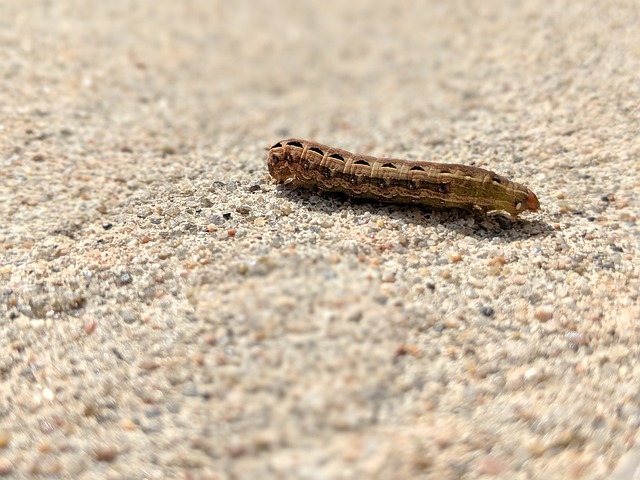
Cutworms are a particularly destructive pest that can kill your lettuce by cutting it off at the stem just above ground level. They are the larvae of various moth species that can be brown, pink, black, pink, or gray.
How to Fix it: If you have found your lettuce plants have been severed at the stems, grab your flashlight and take a wander around your garden at night. These caterpillars are nocturnal and will emerge from the soil at night to feast on your plants.
You can remove cutworms from your plants and the soil surrounding them by hand. Once you have done this, you can make collars out of tinfoil to protect your plants, placing them around the stems of your lettuce. You will need to place the collar a few inches above and below the ground. Diatomaceous Earth speed around the base of the lettuce plants will also help protect them from cutworms.
7. Diseases
Lettuce plants are no strangers to diseases that can wreak havoc on them. Several devastating diseases could be the reason why your lettuce plants are dying. The most common and deadly diseases that can kill your lettuce are:
Lettuce Mosaic Virus
Lettuce mosaic virus is one of the most common diseases, transmitted by one of the most common garden pests, aphids. This viral disease is seed-borne, and therefore can also be introduced to your garden through infected seeds.
Infected plants display mosaic patterns or mottled discoloration on the leaves, stunted growth, and overall plant weakness. Severe infections can result in the death of your lettuce.
How to Fix it: There is no way to fix lettuce mosaic virus, so you will need to remove and destroy all affected plants. The best way to prevent this virus from infecting your lettuce is to control aphid infestations.
Practicing good garden hygiene is another way to prevent this disease, which you can do by sanitizing all garden equipment after use.
Bottom Rot
Bottom rot is a soil-borne fungal disease that usually appears when the temperature is warmer and the weather is wetter. If your lettuce has bottom rot you will notice small brown, sunken spots on the midrib of your plants.
The leaves of your lettuce plant will begin to rot, and the lesions will produce an amber liquid and will begin to smell musky. The head of the lettuce will eventually rot and collapse.
How to Fix it: To fix bottom rot you will need to remove any infected leaves from your lettuce. There is no cure for this fungal disease so preventing an outbreak is key. To prevent bottom rot, make sure your soil is free-draining and consider mounding your soil when planting lettuce. Mounding the soil will keep your lettuce away from any sitting water, where the fungus could be.
Sclerotinia Drop
Sclerotinia drop is the name given to two types of fungal diseases that cause your lettuce to wilt and the appearance of water-soaked lesions on the stems and leaves. Your rotting lettuce plant will eventually collapse and die. This disease will most likely make its appearance after cool, wet weather.
How to Fix it: If your lettuce plants are displaying the telltale signs of sclerotinia drop, remove any affected plants. As with most fungal diseases that can affect your lettuce, there are several things you can do to try and prevent it from infecting your crop.
To prevent an outbreak of sclerotinia drop you need to make sure the soil surrounding your lettuce plants is not overly wet. I have found the best way to do this is to water my lettuce early in the morning so that the soil can dry out during the day.
Bacterial Leaf Spot
Bacterial leaf spot is a common plant disease caused by various species of bacteria. It affects a wide range of plants, including lettuce. The fungal disease is a seed-borne pathogen that will usually appear after cold, wet weather and is spread through water.
The first signs that your lettuce is infected with bacterial leaf spot are small water-soaked lesions on your plant’s outer leaves. These lesions are usually surrounded by a yellow ‘halo.’ The lesions will turn black and merge, which then leads to the collapse of your plant.
How to Fix it: When you spot the first symptoms of bacterial leaf spot, remove the infected leaves immediately. If caught early, you can treat this fungal disease by spraying the infected plants with copper fungicide.
